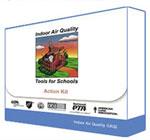Ensuring Correct Ventilation in the Design and Construction Phase for a Healthy School Environment
Creating Healthy Indoor Environments in Schools

EPA offers information and resources for school officials and staff, teachers, health care professionals, parents, and students to help improve indoor air quality in schools. Read more about:
- Indoor Air Quality Tools for Schools Action Kit
- Indoor Air Quality Design Tools for Schools
- School Advanced Ventilation Engineering Software
More about indoor air quality
On this page:
- Why It's Important
- What You Can Do
- EPA and Federal Partners
- National Organizations
- Regional, State and Local Resources
Why It's Important
- Indoor air can be two to five times more polluted than outdoor air.
- Adequate air ventilation, filtration and exhaust can help reduce the effects of radon and carbon monoxide. Well-maintained systems capture and remove airborne vapor, mold and particles that can be asthma triggers, allergens and infectious or toxic to humans.
- Growing evidence suggests that improving outdoor air ventilation can improve student and teacher performance, increase test scores and reduce airborne transmission of infection.
What You Can Do
- Follow the industry's ventilation standards to provide adequate outdoor air, control moisture and minimize energy costs.
- Comply with your state's relevant environmental health policies and emergency management protocols when conducting ventilation and filtration maintenance activities.
- Read the Ensure Good Ventilation section of EPA's model K-12 school environmental health program for more information.
EPA and Federal Partners

IAQ Champions in your area can help with peer-to-peer learning and sharing.
- Video: Tools for Schools Indoor Air Quality Exitby Rutgers University, with support from EPA, presents a two-part video to help identify, prevent and treat common IAQ issues that may arise in schools.
- Indoor Air Quality Scientific Findings Resource Bank (IAQ-SFRB) provides information summarizing the state of scientific knowledge about the relationships between people's health and productivity and the IAQ conditions or associated building characteristics in which the people work or reside. The IAQ-SFRB is run by the Lawrence Berkeley National Laboratory Indoor Environment Group and is funded through an interagency agreement with EPA.
- Ozone Generators That Are Sold as Air Cleaners: An Assessment of Effectiveness and Health Consequences by EPA examines claims that ozone generators improve indoor air quality and control pollution by summarizing peer-reviewed, scientifically supported findings and conclusions.
- Ventilation Standards by the U.S. Department of Labor's Occupational Health & Safety Administration describes standards and their interpretations for the general industry as well as specific construction industries.
- The Building Ventilation page of the Centers for Disease Control and Prevention's Indoor Environmental Quality (IEQ) website explains the importance of HVAC systems as well as what individuals and building managers can do to improve IEQ through HVAC management.
National Organizations
- HVAC Systems in School Buildings: Resource List by the National Clearinghouse for Educational Facilities offers an annotated list of links, books and journal articles on heating, ventilating and air conditioning systems in school facilities.
Regional, State and Local Resources
- Sensible Steps for Healthier School Environments by EPA provides an overview of issues related to indoor air quality and ventilation in schools.
